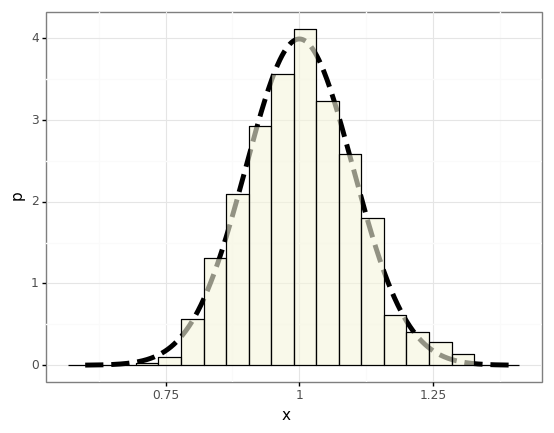Sampling b*sics
We’re on a bit of a roll with the basics, so let’s do a review/examples of common ideas in sampling real quick:
- Inverse CDF trick
- Rejection sampling
- Importance sampling
We’ll also touch on the central limit theorem. We might also come back to Markov chain Monte Carlo later.
# But first, imports.
from typing import Union
import warnings
warnings.filterwarnings('ignore')
import numpy as np
import pandas as pd
import plotnine as gg
from scipy import stats
gg.theme_set(gg.theme_bw());
Inverse CDF trick
Say we’re given a density \(p(x)\) such that its cumulative distribution function \(F(x) = \int_{-\infty}^{x}p(x')\mathrm{d}x'\) is invertible.
If we have \(z\sim\mathcal{U}(0, 1)\), then by change of variables:
\[\begin{align} p(x) &= p(z)\left|\frac{\mathrm{d}z}{\mathrm{d}x}\right| \\ \implies p(x)\mathrm{d}x &= p(z)\mathrm{d}z \\ \implies \underbrace{\int_{-\infty}^x p(x')\mathrm{d}x'}_{F(x)} &= \int_{-\infty}^z p(z')\mathrm{d}z' \\ &= \int_0^z dz' \\ &= z \end{align}\]which implies that \(x=F^{-1}(z)\).
Example
Given a density
\[f(x) = \begin{cases} \frac{1}{2}\sin(x) & x\in[0,\pi] \\ 0 & \mathrm{otherwise} \end{cases}\]So the CDF is
\[\begin{align} F(x) &= \frac{1}{2}\int_{-\infty}^{x}f(x')\mathrm{d}x' \\ &= \frac{1}{2}\int_0^x \sin(x')\mathrm{d}x' \\ &= -\frac{1}{2}\big[\cos(x')\big]_0^x \\ &= \frac{1}{2} - \frac{1}{2}\cos(x) \end{align}\]Inverting this on \([0, \pi]\):
\[F^{-1}(x) = \cos^{-1}(1-2x)\]num_samples = 100000
ys = np.random.rand(num_samples)
xs = np.arccos(1 - 2 * ys)
ps = 0.5 * np.sin(xs)
df = pd.DataFrame({
'x': xs,
'p': ps,
})
p = (gg.ggplot(df)
+ gg.aes(x='x')
+ gg.geom_histogram(gg.aes(y='stat(density)'), bins=30, color='black', fill='pink')
+ gg.geom_line(gg.aes(y='p'), size=2)
)
p
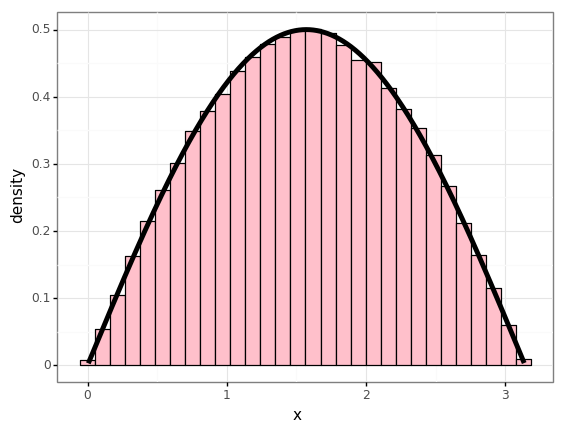
Rejection sampling
Say I’m given a pdf \(p\), but I can’t get its inverse CDF for whatever reason. But, there’s another distribution \(q\) that I do know how to sample from, and I have \(kq(x)\geq p(x)\) everywhere in the support of \(p\). Then we can use rejection sampling:
- Draw \(x\sim q\).
- Accept \(x\) with probability \(\frac{p(x)}{kq(x)}\).
The rejection probability will be
\[\begin{align} Pr(\mathrm{accept}) &= \mathbb{E}_{q}\left[\frac{p(x)}{kq(x)}\right] \\ &= \frac{1}{k}\int_{-\infty}^{\infty}p(x)\frac{q(x)}{q(x)}\mathrm{d}x \\ &= \frac{1}{k}, \end{align}\]so clearly if we want an efficient sampling procedure we want to pick \(q\) such that we don’t require \(k\) too large.
Example
Let’s consider the density:
\[p(x) = \begin{cases} \frac{1}{\pi}\sin^2(x) & x\in[0, 2\pi] \\ 0 & \mathrm{otherwise} \end{cases}\]Say I know how to sample from the normal distribution \(q(x)=\mathcal{N}(\pi, 1)\).
Let’s do rejection sampling.
def p(x: Union[float, np.floating, np.ndarray]) -> Union[float, np.ndarray]:
"""Piecewise definition of p(x)=1/pi sin^2(x) for x in [0, 2pi]."""
lower_bound = 0
upper_bound = 2 * np.pi
y = np.sin(x)**2 / np.pi
if isinstance(x, np.ndarray):
y[x < 0] = 0.
y[x > 2*np.pi] = 0.
elif x < lower_bound or x > upper_bound:
return 0.
return y
# Define q, the distribution we can sample from.
normal = stats.distributions.norm(loc=np.pi)
q = normal.pdf
# Set k=10 (we'll see that this is *just* enough).
k = 10
# Plot these distributions
xs = np.linspace(-np.pi, 3*np.pi, 1000)
qs = k * q(xs)
ps = p(xs)
df = pd.DataFrame({
r'$p(x)$': ps,
r'$kq(x)$': qs,
'x': xs
})
df = pd.melt(df, id_vars=['x'], var_name='distribution', value_name='density')
plot = (gg.ggplot(df)
+ gg.aes(x='x', y='density', color='distribution')
+ gg.geom_line(size=2)
)
plot
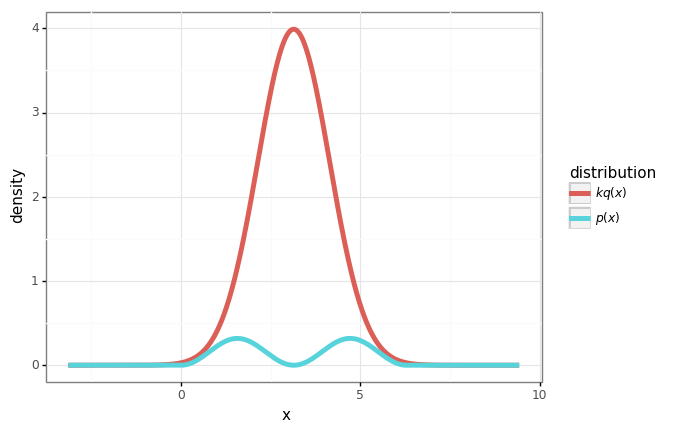
# Do rejection sampling.
num_samples = 10000
samples = normal.rvs(size=num_samples)
ratios = p(samples) / (k * q(samples))
accept = np.random.rand(num_samples) < ratios
accepted_samples = samples[accept]
print('Acceptance rate:', len(accepted_samples) / num_samples, '(k={}).'.format(k))
Acceptance rate: 0.0981 (k=10).
samples_df = pd.DataFrame({'x': accepted_samples})
plot + gg.geom_histogram(data=samples_df, mapping=gg.aes(x='x', y='stat(density)', inherit_aes=False),
bins=50, color='black', fill='teal', alpha=0.6)
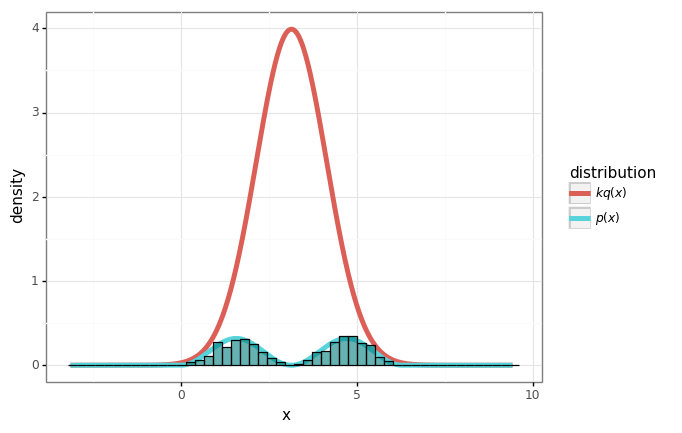
Importance sampling
Often we don’t care so much about drawing samples from some distribution \(p\) but rather to compute expectations of things. This motivates importance sampling:
\[\begin{align} \mathbb{E}_p[f] &= \int f(x) p(x) \mathrm{d} x \\ &= \int f(x) \frac{p(x)}{q(x)} q(x) \mathrm{d} x \\ &= \mathbb{E}_q\left[ f(x) \frac{p(x)}{q(x)} \right]. \end{align}\]This allows us to generate Monte-Carlo estimates of \(f\) w.r.t. \(p\) by drawing samples from a completely different distribution \(q\).
Example
In this example, we’ll use samples from the exponential distribution \(q(x) = e^{-x}\) to compute the mean of the beta distribution \(\beta(2, 2)\).
p = stats.distributions.beta(a=2, b=4)
q = stats.distributions.expon()
xs = np.linspace(0, 5, num=1000)
ps = p.pdf(xs)
qs = q.pdf(xs)
df = pd.DataFrame({
'x': xs,
'p': ps,
'q': qs,
})
df = pd.melt(df, id_vars=['x'], var_name='distribution', value_name='density')
gg.ggplot(df) + gg.aes(x='x', y='density', color='distribution') + gg.geom_line(size=2)
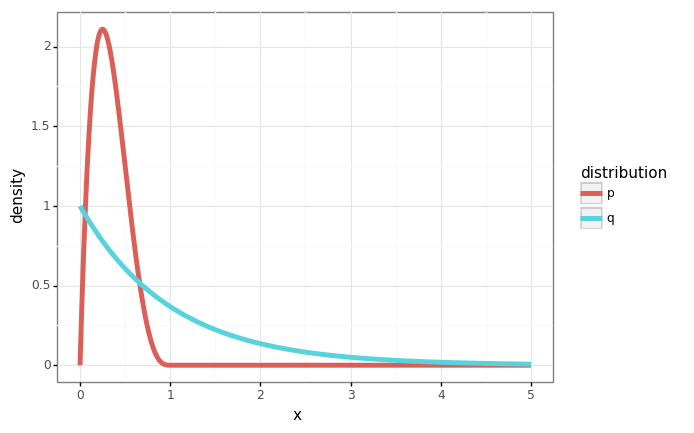
num_samples = 10000
samples = q.rvs(size=num_samples)
mean = np.mean(samples * p.pdf(samples) / q.pdf(samples))
print('Importance weighted estimate: {mean:.4f}. True mean: {true_mean:.4f}.'.format(mean=mean, true_mean=p.mean()))
Importance weighted estimate: 0.3357. True mean: 0.3333.
Central limit theorem
Say we draw a dataset of \(N\) samples i.i.d. from some finite-variance distribution \(p(x)\):
\[\mathcal{D} = \left\{x^{(1)},\ x^{(2)}, \dots, x^{(N)}\right\}\]The central limit theorem (CLT) states that the sample mean
\[\hat{\mu} = \frac{1}{N}\sum_{n=1}^N x^{(n)}\]is a normally-distributed random variable:
\[\hat{\mu} \sim \mathcal{N}\left(\mathbb{E}[X], \frac{\mathrm{Var}[X]}{N}\right)\]Note that this holds regardless of \(p\) – an astonishing result.
Example
To demonstrate this we’ll draw a bunch of different datasets (trials) \(\mathcal{D}\) from an exponential distribution and compute the statistics of the sample mean, and compare them to the distribution we expect from the CLT.
# Empirically compute a histogram of the sample mean for various trials.
num_samples = 100 # Size of D.
num_trials = 1000
p = stats.distributions.expon()
results = []
for _ in range(num_trials):
result = p.rvs(size=num_samples).mean()
results.append(result)
df = pd.DataFrame({
r'$\mu$': np.array(results)
})
# CLT says we should expect the sample mean to follow this distribution.
normal = stats.distributions.norm(loc=p.mean(), scale=np.sqrt(p.var() / num_samples))
xs = np.linspace(0.6, 1.4, num=1000)
p_df = pd.DataFrame({
'x': xs,
'p': normal.pdf(xs)
})
plot = (gg.ggplot(df)
+ gg.geom_line(data=p_df, mapping=gg.aes(x='x', y='p'), size=2, linetype='dashed')
+ gg.geom_histogram(mapping=gg.aes(x='$\mu$', y='stat(density)'), bins=20, colour='black', fill='beige', alpha=0.6)
)
plot
